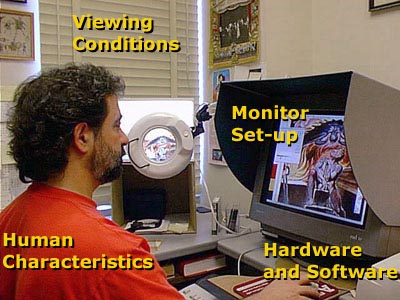

4. Quality Control
Key
Concepts
DEVELOPING
A QC PROGRAM
The following steps outline the main points of a quality control program.
A fully developed strategy for establishing such a program is presented
in Moving
Theory into Practice: Digital Imaging for Libraries and Archives.
1.
Identify Your Products
The first step is to clearly identify the products to be evaluated. These
might include master and derivative images, printouts, image databases,
and accompanying metadata, including converted text and marked-up files.
2.
Develop a Consistent Approach
To measure quality and judge whether the products are satisfactory, clearly
define baseline characteristics for "acceptable" and "unacceptable" digital
products.
| Example:
Defining
Image Quality Parameters for Different Project Goals
If the goal is faithful representation, quality assessment will be based on how well the image conveys the appearance of the original document (detail, color, tone, paper texture, etc.).
Faithful Representation: The color image (left) represents the essence of the original more fully than the grayscale image (right). If the goal is removing a color cast introduced during the photographic process, quality will be judged against the original scene or document (rendering intent), rather than the photograph at hand.
Removing Color Cast: The color shift caused by photography (left) was detected and removed during quality inspection (right). |
3.
Determine a Reference Point
What are you judging the images against? Answering this question is not
always straightforward. For example, if conversion is based on an intermediate,
the digital image is two "generations" away from the original. It has
been copied to film (first generation), which is then scanned (second
generation). What should be the reference point in assessing such an image,
the original document or the transparency? Will the master or derivative
(or both) be the focus of image quality inspection?
4.
Define the Scope and Methods
Determine the scope of your quality review. Will you inspect all the images,
or only on a sampled subset (e.g., 20%)?
Describe your methodology and define how quality judgements will be made. For example, will you visually evaluate the images at 100% (1:1) magnification onscreen and compare them to the original documents? Or, will your evaluation be based only on a subjective assessment of images onscreen, without reference to the originals?
| Example: Because Cornell University Library replaces brittle volumes with digital reprints, image quality evaluation is based on the printouts created from the digital images. A 100% inspection is conducted, comparing each printout to the corresponding original page. |
5.
Control the QC Environment
The impact of image-display conditions on perceived quality is often underestimated.
Given an improper environment, even a high-quality image may come across
as unsatisfactory. For example, a 24-bit color image might look heavily
"posterized" when viewed using an improperly configured computer that
cannot provide a full palette of colors. More information on controlling
the viewing environment is provided in Using
Kodak Photo CD Technology for Preservation and Access.

QC Environment: Image quality evaluation conducted in a controlled environment. Courtesy of William Blake Archive.
Factors affecting on-screen image quality
Hardware
Configuration
It is difficult to prescribe the ideal hardware configuration. The rule
of thumb is to assemble a system that supports your requirements for speed,
memory, storage, and display quality. What kinds of images are being created?
How many? To serve what purposes? What level of on-screen review is needed?
You will need a fast and reliable computer with ample processing power
and memory to be able to retrieve and manipulate the large files you are
creating, especially when creating color images. See also: Technical
Infrastructure: Image Creation.
Image
Retrieval Software
Use retrieval software appropriate to your images. For example, if you
are evaluating images created and stored in Kodak ImagePac format, retrieve
them using one of the viewing freeware and shareware products available
on the Web that support the format and color space. Cornell used Adobe
Photoshop with the Kodak Photo CD Acquire Module plug-in to ensure correct
mapping of Photo CD colors. More information is provided in Using
Kodak Photo CD Technology for Preservation and Access.
Viewing
Conditions
Control your viewing environment. Understand that the monitor and the
source document require distinct viewing conditions. The original is best
viewed in a bright surrounding, and the monitor works best in a low-light
environment. However, a low-light environment does not equate to a dark
room. Viewed in the dark, an on-screen image would appear deficient in
contrast.
Human
Characteristics
Image quality assessment requires visual sophistication, especially for
subjective evaluations. Ideally, the same person should evaluate all images,
using the same equipment and settings. In particular, staff need training
to communicate color appearance information effectively.
Some color vision deficiencies are linked to a defective, recessive gene on the X chromosome. Since females have two X chromosomes and males have one, the chance of color-deficient vision is 1 in 250 females, but 1 in 12 for males. Even among expert viewers, differences in judgments due to normal variation in the human eye are not uncommon. A color vision test can be used to evaluate a viewer's vision.
Monitor
Calibration
Images may appear different on different monitors. Calibration is the
process of adjusting monitor color-conversion settings to a standard,
so that the image displays the same on a variety of monitors. The ideal
method is to use monitor-calibration hardware and accompanying software.
However, if you do not have access to these resources, use your application
program's calibration tools. For example, Adobe Photoshop includes a basic
monitor-calibration tool, which can be used to eliminate color cast and
standardize the display of images.
Color
Management
One of the main challenges in digitizing color documents is to maintain
color appearance and consistency across the digitization chain, including
scanning, displaying, and printing. Accurately reproducing colors is difficult
because input and output devices treat colors differently. The goal of
color management system (CMS) software is to ensure that the colors of
the original match as precisely as possible the digital reproduction on-screen
or printed out.
6.
Evaluate System Performance
Whether conversion takes place in-house or is outsourced, system performance
should be evaluated to ensure consistency throughout the conversion process.
Among characteristics to evaluate are resolution, linearity, flare, scanner
noise, color reproduction, and various artifacts. Several publications
noted at the end of this section provide further information on system
calibration.
7.
Codify Your Inspection Procedures
Quality control data has long-term value, from supporting different stages
of quality inspection to facilitating future manipulation and migration.
For in-house components of QC, we recommend detailing the inspection procedures
in a short manual (or in a series of workforms) to be used in training
and to facilitate workflow. Issues that need to be addressed include:
QC procedures; staff involved and skills needed; instruments, hardware,
and software needs; rejecting and replacing unacceptable products. An
example of this approach is demonstrated by the Library of Congress in
its Internal
Training Guide.
|
Reality Check You retrieve an image from a CD that just arrived from the image production unit. The image is not crisp and looks darker than what you had expected. What is the first thing to do to determine the cause of the problem? |
© 2000-2003 Cornell University Library/Research Department

